|
This mine was created as part of a friendly online community modelling contest among some very fine modellers from all over the country. The hoist was not part of the model, but was added on based on some old photographs of the original mine. The following is the geological survey location of the mine as it stands today and some historical information.
Yankee Girl Mine, Poughkeepsie Gulch, Red Mountain District, San Juan Co., Colorado, USA
Latitude & Longitude (WGS84): 37 degrees 53' North , 107 degrees 39' West
Latitude & Longitude (Decimal Degrees): 37.8833333333, -107.65
Latitude & Longitude (Degrees plus Decimal Minutes): 37 degrees 53', -107 degrees 39'
--U.S. Geological Survey
On Aug. 14, 1882, prospector John Robinson, out hunting in the rarefied air, exhausted from climbing up the steep slopes of Red Mountain, sat down to rest. He spotted a piece of rock. When he picked it up, he noticed that it was unusually heavy, a sure sign that it was mineralized. Robinson broke the piece in half and saw a silver-gray metallic mineral called galena, typically composed of a mixture of lead, silver, and other metals. Realizing this was a rich find, Robinson began to search for the source of the galena. He soon found an exposed vein and claimed it in his name and those of his partners, Andrew Meldrum, A. E. "Gus" Lang, and August Dietlef.
Robinson returned with his partners to determine the extent of the claim and the men dug a shallow shaft a dozen feet deep. Much to their delight, they dug through solid metallic ore extending the width of the shaft. As a precaution, they staked claims on all four sides, as the ore body seemed to have no limit. Of these claims, the Orphan Boy and the Robinson became major silver producers, but their original discovery, the Yankee Girl, drew the greatest attention to the Red Mountain district.
It turned out that the men had hit the top of a vertical shaft, a chimney, of solid ore, a rare occurrence in the mining world. The prospectors dug out 4,500 pounds of ore, placed it in sacks, and sent a long pack train down to a smelter in Ouray. The mill produced an average of 88 ounces of silver per ton. More than half of the ore was lead, which was valuable to smelters for use as flux.
The Yankee Girl shaft house above the mine has a bull wheel and wire for getting out ore. The mine produced silver, copper, and gold, about $8,000,000 worth in its time. There were problems; digging caused water to fill the shafts. They bought a $30,000 pump to keep the water out, but corrosive water eroded the pump in just one month.
In 1883, the Yankee Girl was joined with the Robinson and Orphan Boy mines by interconnecting tunnels. Eventually, these tunnels reached a length of 25 miles. A boarding house was constructed at the Yankee Girl for the miners. The mine was sold for $125,000 (worth about $2.5 million in today's dollars), giving the men enough money to finance development of their other mines.
--Kenneth Jessen (edited)
Mining created the need for a town. Gusto, Colorado, located at the foot of Champion Gulch on the Silverton Railroad line, formed around the workings of three large mines; the Guston-Robinson, the Yankee Girl, and the Genessee-Vanderbilt. The Guston post office was established on January 26th, 1892, and closed on November 16th, 1898. An English preacher, a Rev. William Davis, succeeded in establishing a church in Guston in 1892. (He had been unsuccessful in establishing one in Red Mountain Town.) The day the church was dedicated in Guston, a fire in Red Mountain destroyed the town's commercial district. More than one resident of Red Mountain questioned the connection to divine intervention. The church at Guston not only had a bell, it also had a steam whistle to signal miners that services were about to start.
Guston declined rapidly after the Silver Panic of 1893. The effects of later sporadic workings and recent environmental cleanup have removed any traces of residences, although the shaft house of the Yankee Girl, and a few remains of the Guston-Robinson mine still stand.
--Jerry Clark (edited)
And then there is this very solid information quoted directly from the U.S. Geological Survey, 1901, "A Report on the Economic Geology of the Silverton Quadrangle, Colorado" written by Frederick Leslie Ransom:
Yankee Girl mine. The Yankee Girl ore body was discovered in the autumn of 1881 by John Robinson. In 1882 it was being opened by two shafts, each about 50 feet deep. At that depth the ore is. said to have been about 9 feet wide, consisting chiefly of galena with bunches of chalcopyrite, and carrying as much as 80 ounces of silver and 6o per cent of lead. The ore body was rapidly opened up and proved large and rich. In 1883, with a thousand feet of drifts and shafts, about 3,000 tons of ore were extracted, with an average value of nearly $150 per ton. The product for this year is given in the Mint report as $400,000, and the ore is said to have carried a high percentage of lead. In 1884, according to the same authority, the mine was producing about 40 tons a day, which, at $150 per ton, would be something over $2,000,000 for the year. This, however, is obviously an excessive estimate. In 1887 the output is not known, but was probably much less than $200,000. In 1890 it is credited with $1,352,994, the silver, as usual, being given at its coinage value and no return being made for copper or lead. In 1891 the product is given as $601,465 in gold and silver, and in 1892 it had fallen to $95,445. Of this amount $5,200 was in gold, $48,333 in silver (coinage value), $3,632 in lead, and $38,280 in copper. Thus these fragmentary records show that in the course of ten years' working the ore changed, within a vertical distance of 1,000 feet, from one carrying chiefly galena to one rich in copper. This has probably been the most widely known and most productive mine in the Red Mountain district, although closely rivaled by the Guston. But it was an expensive mine to operate on account of the irregular form of its large ore bodies, the abundance and corrosive activity of its waters, and the necessity of hoisting and pumping through deep shafts. These adverse conditions, in conjunction with a falling off in the value of the ore caused the mine to shut down about 1896. ...
At present the Yankee Girl shaft is about 1,050 feet in depth. A plan of the extensive levels shows an intricate maze of workings in which no linear system is discernible. The mass of the workings lie just west of the shaft, and in plan may be roughly inclosed in an irregular triangle. A smaller extent of workings lies just east of the shaft. Inspection of the dump, as well as inquiry, shows that there was never much vein quartz associated with the ore. The "quartz" of the miners is very largely the bleached and silicifled country rock adjacent to the nearly solid bodies of ore. Where vein quartz occurs it usually carries iron pyrite. Barite, in small masses and crystals, occurs embedded in the bornite. The chalcocite is generally inti mately associated with small amounts of chalcopyrite. Some speci mens show that the ore has been fractured and recemented by veinlets of calcite. The ore minerals observed on the dump were galena, sphalerite, chalcocite (stromeyerite), bornite, chalcopyrite, and pyrite. Cosalite was recognized in 1884, therefore, in the upper part of the deposit...Proustite and polybasite also occurred occasionally in the Yankee Girl ore bodies. All accounts of the Yankee Girl mine unite in emphasizing the chemical activity of the underground waters encountered in the workings. According to Schwarz they contained "24 grains per gallon of sulphuric acid (SO3)." Candlesticks, picks, or other iron or steel tools left in this water become quickly coated with copper. Iron pipes and rails were rapidly destroyed, and the constant replacement of the piping and pumps necessary to handle the abundant water was a large item in the working expenses. All agree in stating that the water entered far less abundantly below the sixth level. Some who worked in the mine express it as being " not so bad" below that level. But closer inquiry usually elicits the information that it was less abundant but as much or even more corrosive than at the upper levels.
The product of the Yankee Girl is roughly estimated at about $3,000,000.
Now, here are some of the prototype pictures used to guide the modelling of this mine.
What you see below are details of pictures; if you select the small picture, a larger, complete picture will appear.
So now, without further ado, here are pictures of the process of the build:
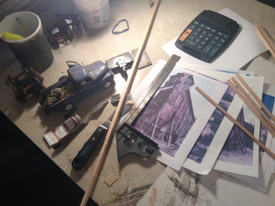
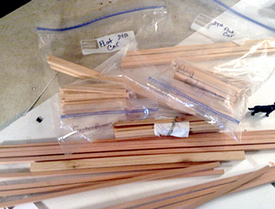
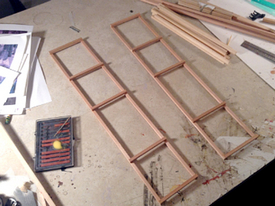
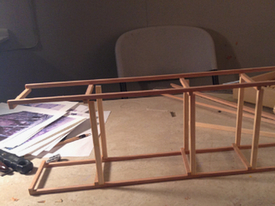
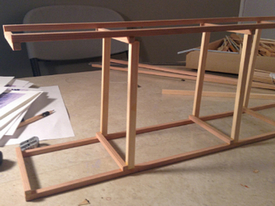
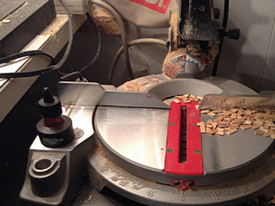
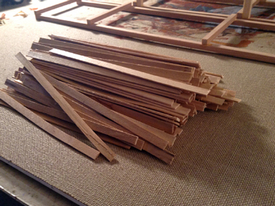
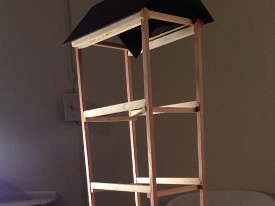
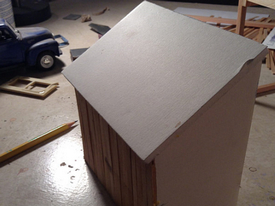
These pictures represent the most critical initial stage of the build because this is where you must make a final commitment
to the overall proportions of the build. If the proportions are wrong at this stage of the build no amount of detailing or finish
will correct the basic mistake, so a lot of time is well-spent here to judge and evaluate whether the overall proportions look right. This build is about 24 inches tall, by the way, roughly a 1:24 scale of the prototype.
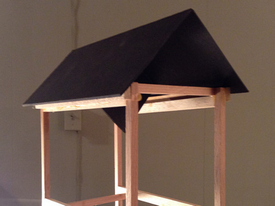
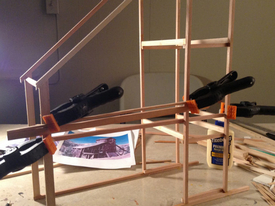
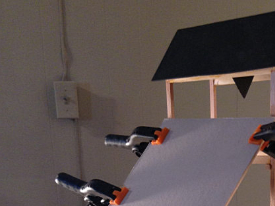
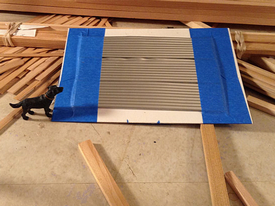
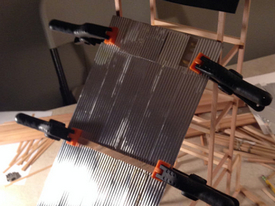
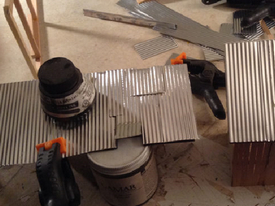
Here are the paints used to paint and weather the corrugated tin roofing: they are an acrylic/gouache combination paint
and the colors are sepia (or you can used raw umber), burnt sienna, black, and, of course, white. The process is to paint
a base coat of a rust color, then to go in with variations on the theme of rust. Variation is the key to making it believeable.
Once all the paint has dried, sometimes you might use a sepia drawing or fountain pen ink to darken and stain some places.
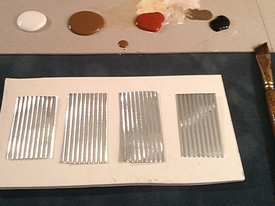
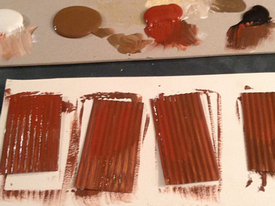
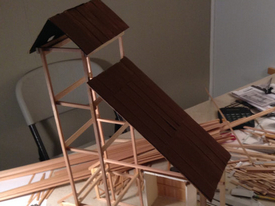
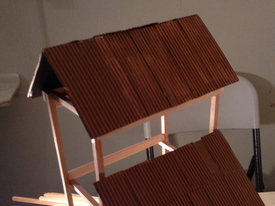
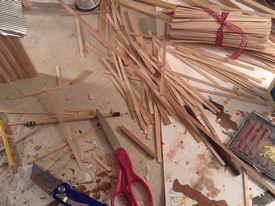
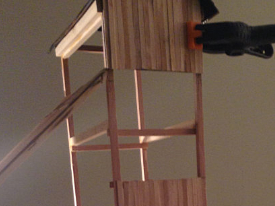
The middle picture is a test stain, on the inside of the structure, to see how the weathering of the wood planking on the mine
would look. This is too dark and it was adjusted on the outside staining. The wood is all staining, no painting except to make
up for a mistake here or there. The stain is entirely made up of different mixtures or drawing ink: blue, black, a burnt sienna
or red if you like, and sepia, which is basically a dull red.
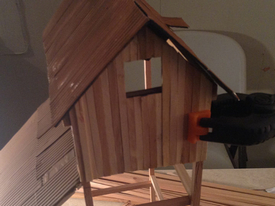
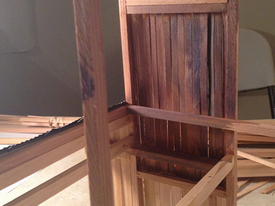
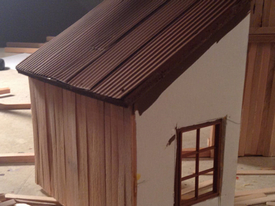



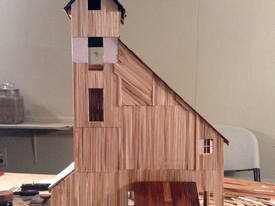
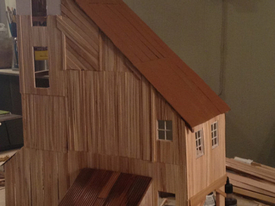
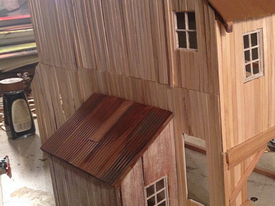
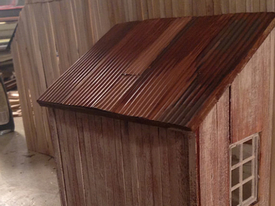
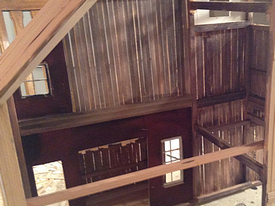
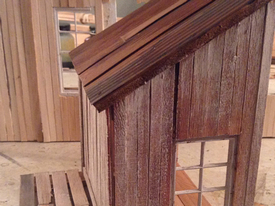
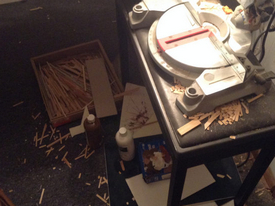
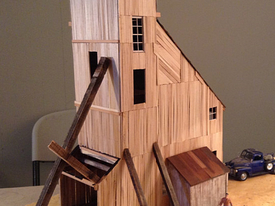
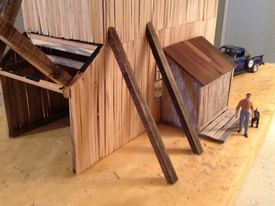
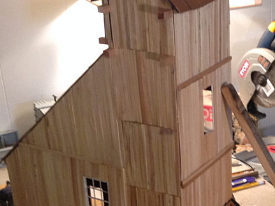
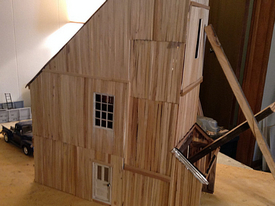
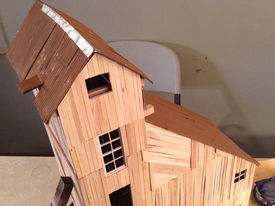
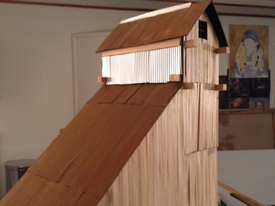
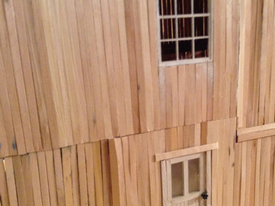
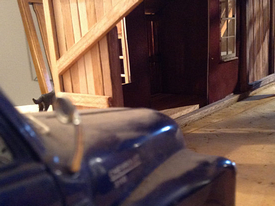
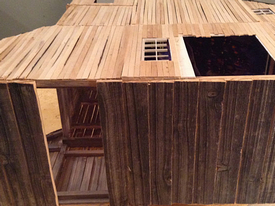
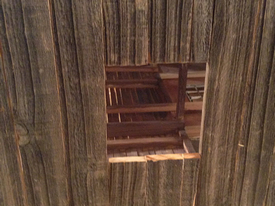
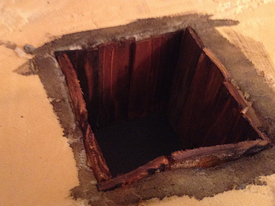
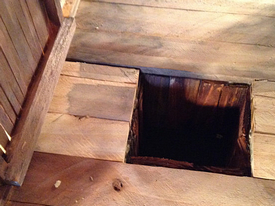
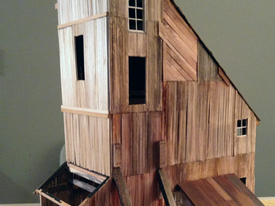
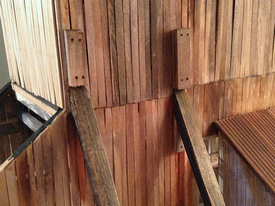
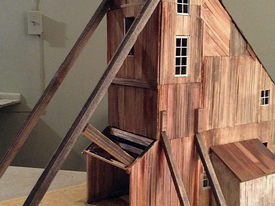
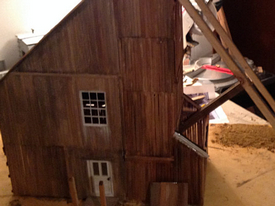
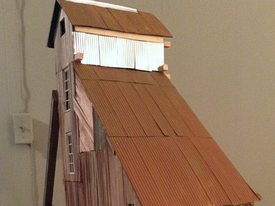
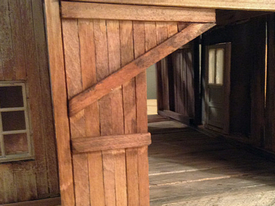
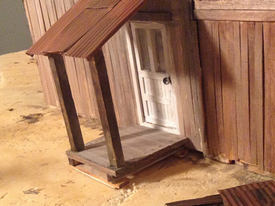
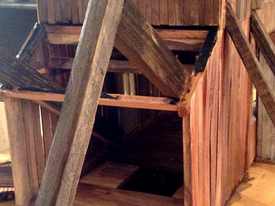
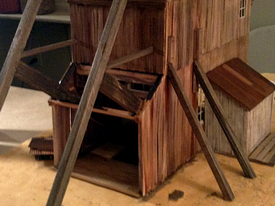
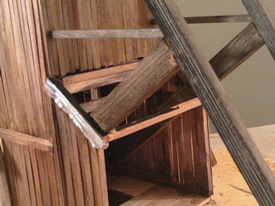
Beginning with the picture below, these are the final pictures of the finished mine. It measures
24 inches tall, 26 inches from one end to the other including the support beams, and is 12 inches wide including the
porch and the shed. Having glued down the long roof, there is no way of blacking out the interior and putting in window
glazing, so the roof has to be removed somehow so that the interior can be finished, including lights, which necessitates the
blacking out of the interior so that the spaces between the planks don't leak too much light out, which would be a strange
effect! Once the structure gets onto the layout pictures will be posted in Structures.
Thanks for viewing!
Any comments, questions, or suggestions you might have are more than welcome.
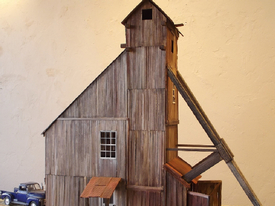
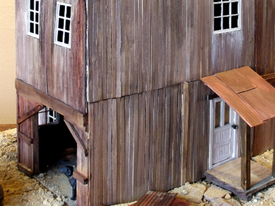
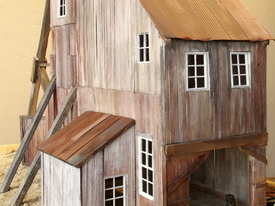
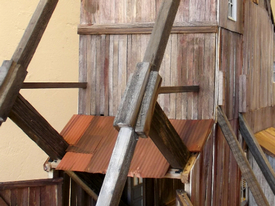
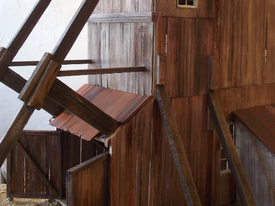
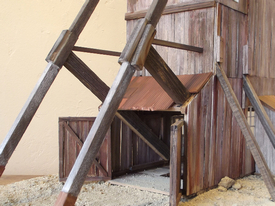
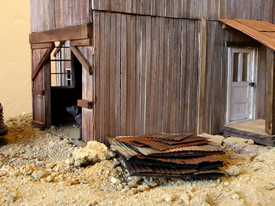
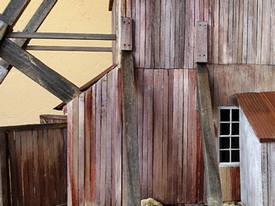
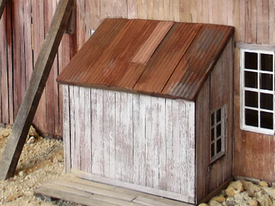
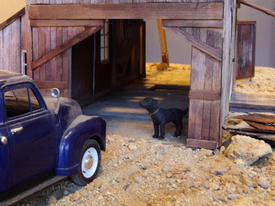
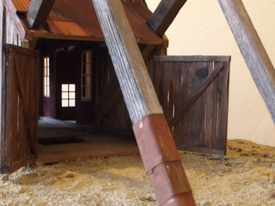
(c) copyright 2016 Saint Francis Consolidated Railroad, LLC. All rights to the images and text on this website are reserved.
(c) copyright 2001-2016 Devin Inc website design and coding
|

